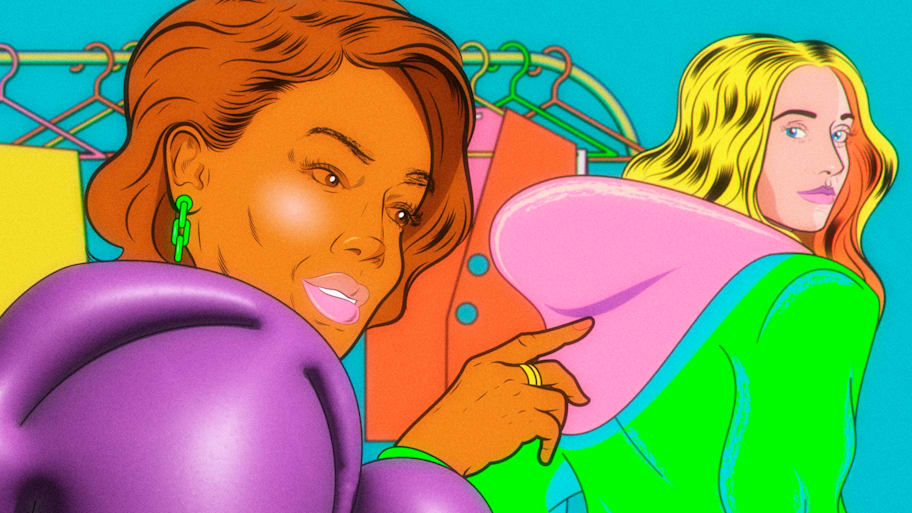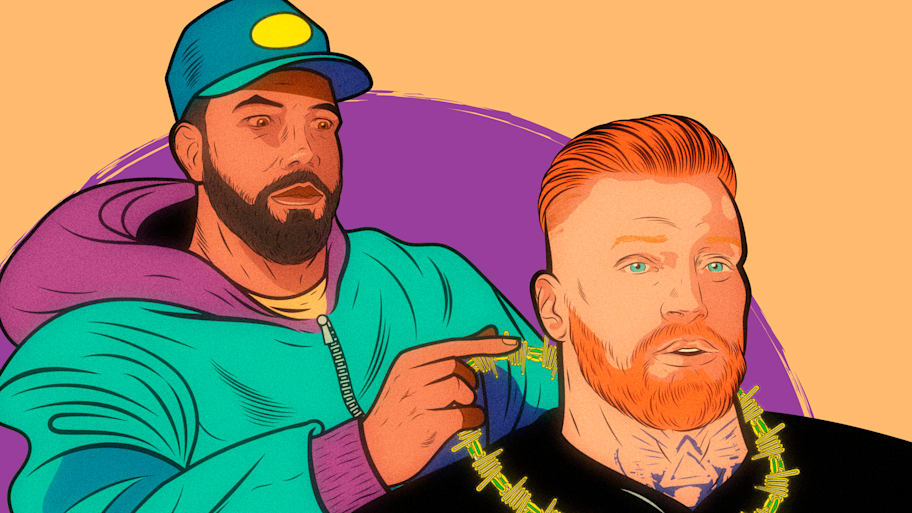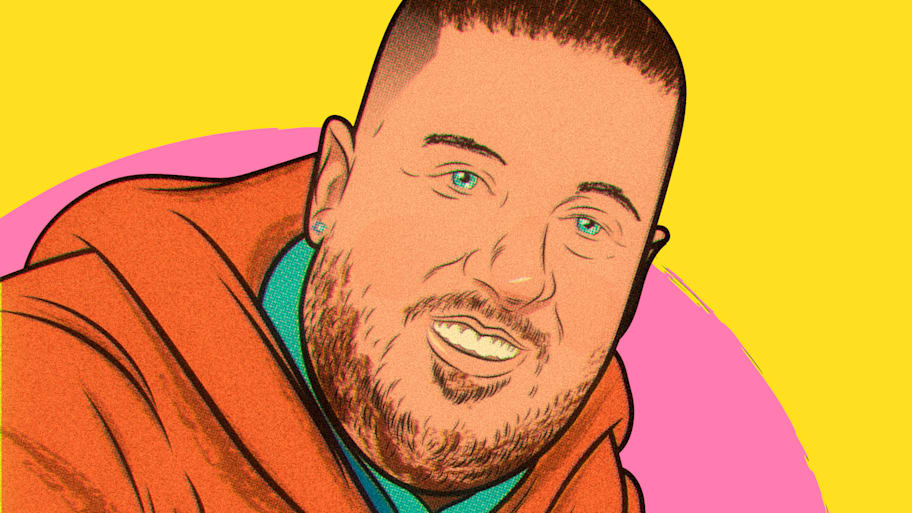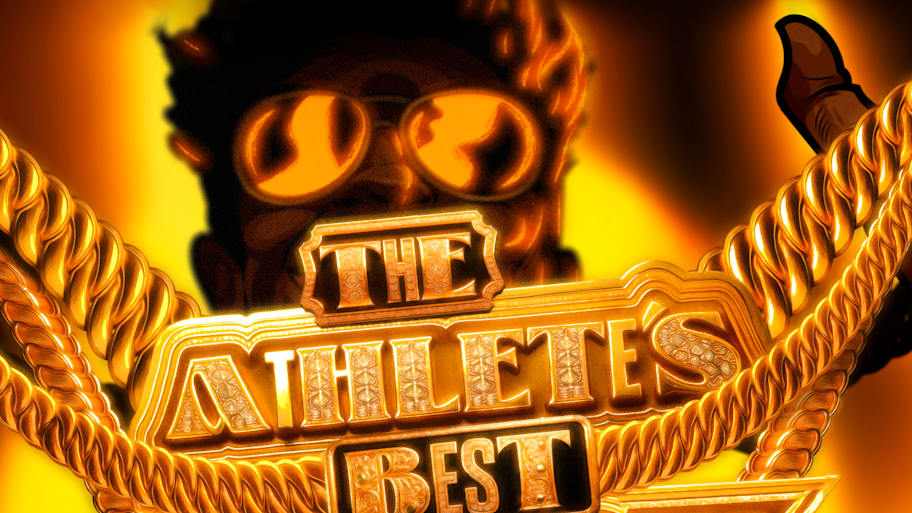Behind every style-conscious athlete is a squad of specialists, employed to handle the finer fashion details that elevate a look to superstar status. From stylists and tailors, to personal jewelers and the people behind the camera snapping a photo of every finished look, here's a look at how the experts get it done.
Brittany Hampton, stylist

Shlepping, shipping and scheduling may seem like the main duties of a UPS driver, but they are critical functions of professional athlete stylists, too.
The increasingly popular job may appear to be all glitz and glamour, with athletes in their red-carpet-ready, designer-laden ensembles, but as Brittany Hampton—stylist to Wings guard Paige Bueckers, Storm forward Nneka Ogwumike, Sparks guard Kelsey Plum, Liberty guard Sabrina Ionescu, tennis player Sloane Stephens, Tigers pitcher Jack Flaherty, Cavs forward Evan Mobley and more—attests, a lot of people don’t realize the hours of work, research and logistics that go into each and every look.
“It’s a lot of shopping and a lot of returns. And a lot of running around,” says the 36-year-old, who has her Hampton Creative Consulting full-time team of six split between New York City and Los Angeles to help fulfill the needs of her clients around the country and across various pro leagues. “We truly are magicians.”
Her “start-to-finish” process typically begins with a meeting to gather a full understanding of an athlete’s likes and dislikes when it comes to trends, brands, silhouettes, colors and fabrics. From there, Hampton will create a mood board and begin outreach to various fashion labels and designers to start sourcing pieces, before scheduling fittings with the athlete, which can take two to five hours for a season’s worth of looks.
“One thing that we’ve gained privilege to, with the growing intersection between sports and fashion, is that a lot of brands are really open to gifting and loaning, and to helping with those tunnel-look moments,” Hampton says. “I think they’ve realized it’s marketable.”
A San Francisco native of Filipino descent, Hampton got her start in the industry through her grandmother, who was a fashion designer and set her on a child modeling track. At 16, Hampton started working in retail stores such as Banana Republic, and later studied at the City College of San Francisco and the Fashion Institute of Design & Merchandising in Los Angeles. In 2019, Hampton began working with Russell Westbrook, styling him and his wife, Nina, for five years while also working on his clothing brand, Honor the Gift, which she helped expand into women’s and children’s lines.
While Hampton plans to sign on additional NFL and MLB athletes this year, it’s not a coincidence that the majority of her clients are women, particularly in the WNBA. For years, the league has been recognized and celebrated for its LGBTQ+ inclusion and gender diversity with its players, partners and fans. And that also translates to the athletes’ fashion sense and personal style—W players continue to push boundaries and showcase a wide range of preferences, ranging from conventionally feminine to more masculine choices.
“[Hampton has] helped me to become more comfortable in my own skin and doesn’t let me feel ashamed for getting stuff out of the men’s section or for being in menswear versus womenswear,” says Bueckers, the WNBA’s No. 1 draft pick this year. “She’s embraced that and helped me find the perfect balance.”
Stylists stress that their role is much more than simply shopping and selecting an outfit. Hampton says she tries to understand an athlete on a deeper level, so she can help convey their background, community or overall story through their attire. It’s also about managing the hectic travel schedules of athletes across different leagues—Hampton and her team will prepack multiple looks for a series of games or a road trip, but last-minute changes and sourcing of specific pieces can sometimes create chaos.
“There’s all these different elements you have to pull together—the makeup artist, the hair stylist,” Hampton says. “We don’t just pull a rack of clothes. We’re not personal shoppers. We create something, start to finish. It’s about making that vision come true.” —Jamie Lisanti
Zohaib Muhammad, jeweler

Zohaib Muhammad had just five days to source 3,622 precious stones—3,444 diamonds and 178 emeralds, plus 836.47 grams of rose gold, to be exact—and create a custom design for a three-by-three-inch letter “E” pendant and 22-inch chain with barbed wire details. The Houston-based jeweler—better known as ZoFrost—received the request from his buddy and client, Maxx Crosby. The Raiders’ defensive end was attending a field dedication at Eastern Michigan, his alma mater, and he wanted a showstopper. It needed to be blinged out with gold, diamonds and lots of EMU green. And it needed to be big.
“I don’t know why I said yes,” ZoFrost says. “If one thing went wrong, we wouldn’t have made the deadline. He doesn’t know how much sleep I lost over that piece. He’s a good friend, but I told him, never do that to me again.”
ZoFrost’s showroom houses jewelry for some of the biggest names in the NFL and NBA. He designed the diamond chains and cross pendant that Thunder star Shai Gilgeous-Alexander wore throughout the 2024–25 season. LaMelo Ball has also commissioned several pieces from ZoFrost, including a new Chrome Hearts- inspired, full-mouth grill cast in white gold that was made locally in Houston. ZoFrost says he loves designing for Ball: “That guy keeps you on your toes.”
ZoFrost sources stones and diamonds from the world’s best refineries in India. Of course, he has a large inventory on hand for when requests come in. “I tell clients two weeks, minimum,” he says. “Five days is just crazy.”
Clients approach ZoFrost for all kinds of reasons, like when Bears safety Jonathan Owens commissioned an engagement ring for Simone Biles, a three-carat, oval- cut diamond set on a pavé band. But most of the time, it’s to put a show of force behind an athlete’s name with a big piece of custom jewelry. Usually, it’s a pendant or chain. ZoFrost says, “They worked hard, they made it to the league—it’s time to flash out a bit.”
Regardless of size, the process remains the same. ZoFrost discusses the idea with his client, like a pendant with a logo, a player’s number or a team mascot. After the budget is discussed (often with the help of a financial adviser), the concept moves to mockup, which includes cuts, size, color and style of diamonds and stones. Once a full rendering of the finished product is approved, ZoFrost creates a mold, an exact 3-D replica. Then a casting of the backbone—the infrastructure that holds the stones—is produced. When it all gets set and polished, ZoFrost looks it over for quality control—he aims to operate with the same work ethic and attention to detail his clients put into their sports.
Enormous gold pendants and chains covered in diamonds make a statement on their own, but ZoFrost feels he’s part of a changing trend in how players approach fashion. “Athletes are building entire looks around jewelry,” he says. “Before you would ice up a bunch of round diamonds, now it’s all about how big you can go. A few years ago, I started mixing different cuts and stones, really pushing the design, and now you see it everywhere. The jewelry and the designs have gotten huge. Literally huge.”
Championship pendants for the WNBA’s Aces, chains for Lamar Jackson, a cross pendant for DeAndre Ayton, Derrick Henry’s king pendant—all of it top of the line. But as blingy as his jewelry gets, ZoFrost’s start has a simple origin story. “I was selling jewelry in a Houston mall to put myself through school,” says the 38-year-old. “Growing up playing, loving sports is a big part of why I’m in this profession. Jewelry has kept me close to the game.”
Staying close to players he knew from childhood produced a small circle of professional athletes—a group that has grown into a client base of some of the most recognizable names in sports, primarily through word of mouth. “If somebody in the locker room is wearing your stuff, that’s your billboard,” ZoFrost says. “If you do good work, and you take care of people, it ultimately leads to some big names.”
With big names come big pieces. ZoFrost says he’s blessed with a career he loves, but if he could make a piece for anyone or anything, it would be a small one. Something littler than a pendant, but with a bigger impact: “I want to make a championship ring,” he says. “That would be the ultimate.” —Kim Curzi
Tom Marchitelli, tailor

For his arrival to Game 4 of the NHL’s Western Conference finals, Oilers winger Evander Kane chose a cashmere brown and tan striped suit, paired with matching brown and white Nike Dunk Lows. It was the perfect palette to contrast against his neon green Lamborghini Urus, and only one of many striking suits he wore during the playoffs.
There’s a strong chance that some of the most memorable garments worn by your favorite NBA, NFL, NHL or MLB players was a custom suit made by Tom Marchitelli, founder of the custom menswear tailoring company Gentleman’s Playbook. Joe Burrow’s gray and black tiger-striped jacket and pants for Super Bowl LVI; Josh Allen’s head-to-toe seafoam green look for the 2023 Kentucky Derby; and any of the 150-plus suits Dak Prescott has commissioned over the last nine years were all made by Marchitelli.
The New Jersey-based designer considers himself a walking billboard. “I’m always in a suit,” he says. It’s how he met Rob Gronkowski. “I was at a Super Bowl event fitting Todd Gurley and Gronk asked me where I got my suit. I told him I made it, then convinced him he needed [one] for the Super Bowl. I fit him right there.” Marchitelli had it done in 72 hours—an icy blue plaid three-piece suit in pure Italian wool, fit to the former tight end’s 6' 6" frame. As a surprise, he had Gronk’s number No. 87 and an image of him spiking the ball embroidered on the jacket’s lining. In Gronk’s words: “That’s what I’m talking about, baby!”
Most of Marchitelli’s fabrics are sourced from Italy: wool for a suit that needs to be more functional, silk when the piece moves into more elevated territory. And cashmere is always in play. But everything is sewn in Los Angeles.
A custom suit, which costs between $3,000 and $5,000, takes about three weeks to complete, and it starts with a thorough first fitting, which can last as long as three hours. Marchitelli painstakingly takes measurements of an athlete’s chest, arms, wrists, thighs, hips, inseam length and more, then discusses fabric choices, buttons, thread colors and other minute details. The suit is then cut and sewn, and second or third fittings take place for alterations. “I fly to all the fittings,” says Marchitelli, 43. “I go over how to wear it, how to button it, how to sit down in it. I want it to fit like a glove. I want my clients to look like a million bucks.”
Fitting a range of athletic bodies is all about scale and proportion. Suits need to be perfectly sized to allow for the large taper that occurs from broad shoulders to a thin waist, or to accommodate extra wide hips or muscular quads. Marchitelli considers every detail, even making sure the pant leg looks good with sneakers—a common request.
Marchitelli learned to measure when he was dissatisfied with the way his own suits fit, converting his own bold style and a popular Instagram account into a business designing ensembles not only for the biggest names in sport, but for some of the most significant moments in their lives as well. He made multiple pieces for Allen’s May 31 wedding to actress Hailee Steinfeld. “An ivory suit is my favorite piece of men’s formal wear,” Marchitelli says of the quarterback’s reception attire. “It’s just classic.”
An elegant and timeless silhouette is what Marchitelli considers his signature sartorial style, but the material? The fabrics are where it gets loud. “It’s all about being one-of-one,” he says. And when you’re working with the world’s top athletes, no two looks can be the same.
Take Prescott’s collection of suits. It’s been nearly a decade since he started working with Marchitelli, but the Dallas quarterback has never repeated a look.
That keeps the designer on his toes.
“I can’t show up with just anything,” Marchitelli says. “I go deep into my bag for the most unique, abstract prints I can find—prints no other clothier can get." —K.C.
Jim Poorten, photographer

Scroll the social media timelines of your favorite NBA players and personalities and you will often see a familiar photo credit: Jim Ice. LeBron James at a Lakers game? Jim Ice. Tyrese Haliburton in the conference finals? Jim Ice. Even when he’s not credited, if it’s from a big moment in a big game, there’s a good chance it came from Ice’s camera.
Ice, whose real name is Jim Poorten, stumbled into his photography career. A former video coordinator at Seton Hall, Ice joined the NBA in 2006, cutting tape for the league’s website. In ’09, with the popularity of Twitter (now X) on the rise, the NBA was figuring out how to staff the social sites. Ice volunteered. His first assignment was collecting video from Vince Carter’s return to New Jersey after the guard joined the Magic. Now 41, Ice has been a courtside mainstay ever since.
Ice, officially the NBA’s senior manager of social content publishing, largely keeps his lens aimed at the floor. In recent years, though, there has been increasing interest in images from off the court. Players have turned the short walk from the parking lot to the locker room into a makeshift runway to show off pregame fits. James in his Louis Vuitton. Kyle Kuzma in his Pepto-pink Raf Simons sweater. Russell Westbrook, one of the NBA’s most daring dressers, once arrived at a game in a photographer’s vest.
Shai Gilgeous-Alexander, the reigning MVP, posts more fashion shots than fallaway jumpers on his Instagram. “You can look at some players’ pages and not even know they are basketball players,” says Ice. “For some, it’s mostly just outfits.”
Ice traces the interest in pregame style to the 2002 NBA Finals, when Kobe Bryant arrived at the arena for each game in a different throwback jersey. “He used it to pay tribute to others,” says Ice, who picked up his nickname from a former Seton Hall staffer who noted his love for throwback jerseys and long chains. “He used it to tell a story with what he was wearing. But that swag, the way he walked, he was putting on a show.”
For Ice, fashion has become a critical part of storytelling. Disappearing Instagram Stories became a platform where he could tell the full narrative of a game night “without bombarding the feed.” The appetite for details about stars—any details—is insatiable. Everything from shoes to accessories to what kind of headphones a player is wearing generates interest. “It’s how we begin our coverage,” says Ice.
The Los Angeles-based Ice often arrives at Lakers games five hours before tip-off just to capture James’s seconds-long arrival. Once a one-man band, Ice is now a senior leader on a staff of dozens that has given the NBA a nine-figure footprint on its social channels.
Ice laughs at the reach of his fashion photos. Social accounts from Slam magazine to GQ will pick them up, most more interesting to Annie Leibovitz than Adam Silver. There are accounts solely dedicated to NBA style. Players can pull them off a league-operated Greenfly account but some will still dive into Ice’s DMs, hoping that he caught their latest fit.
“The whole job is just the dream come true,” says Ice. “I’m not going to lie, the guys notice it too. During the regular season when I’m hopping around, guys will be like, ‘Oh, it’s a big game. Ice is here.’ They’ll be happy to see that they’re getting the extra coverage from us. It’s a blessing, and I guess it’s just where I belong.” —Chris Mannix
This article was originally published on www.si.com as Meet the Specialists Behind the Most Stylish Athletes in Sports.
